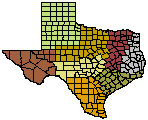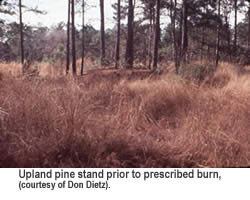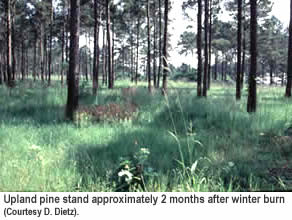- Trans Pecos
- High Plains/Panhandle
- Cross Timbers
- Hill Country
- Post Oak Savannah
- Pineywoods
- Oak Prairie
- South Texas Plains

Wildlife Division District Map
Pineywoods Wildlife Management
Habitat Management
Fire
 The
pine forests of the southeast United States evolved with periodic fires. Frequent
fires set by Indians and lightning were part of the Southern forest ecosystem
for thousands of years, most ecologists believe. Prescribed fires can be utilized
to replace the naturally occurring fires. Prescribed burning is the planned
application of fire to enhance habitat and plant diversity, increase food,
manipulate cover, or improve the structure of the habitat. Prescribed burning
is an effective, low cost habitat management tool that can be used to "mimic"
the natural cycle of burning.
The
pine forests of the southeast United States evolved with periodic fires. Frequent
fires set by Indians and lightning were part of the Southern forest ecosystem
for thousands of years, most ecologists believe. Prescribed fires can be utilized
to replace the naturally occurring fires. Prescribed burning is the planned
application of fire to enhance habitat and plant diversity, increase food,
manipulate cover, or improve the structure of the habitat. Prescribed burning
is an effective, low cost habitat management tool that can be used to "mimic"
the natural cycle of burning.
 A
regular burning program can be used to maintain open understory conditions
in pine and mixed pine and hardwood stands. Burns are less volatile if conducted
during the dormant season (winter). Cool season burns will reduce the amount
of debris on the ground and improve habitat conditions for many species of
wildlife. Burning stimulates the production of herbaceous vegetation and legumes,
and improves the quality of existing browse plants by killing the above ground
portion of the smaller plants, causing the plants to resprout from the roots.
In addition to these sprouts being more nutritious and palatable, they are
reduced in height and more available to wildlife. Fire also reduces accumulated
dead matter and obstacles that restrict movement of ground foraging birds.
If the goal is to reduce woody vegetation and promote the growth of grasses
and other herbaceous vegetation, growing season burns can be utilized.
A
regular burning program can be used to maintain open understory conditions
in pine and mixed pine and hardwood stands. Burns are less volatile if conducted
during the dormant season (winter). Cool season burns will reduce the amount
of debris on the ground and improve habitat conditions for many species of
wildlife. Burning stimulates the production of herbaceous vegetation and legumes,
and improves the quality of existing browse plants by killing the above ground
portion of the smaller plants, causing the plants to resprout from the roots.
In addition to these sprouts being more nutritious and palatable, they are
reduced in height and more available to wildlife. Fire also reduces accumulated
dead matter and obstacles that restrict movement of ground foraging birds.
If the goal is to reduce woody vegetation and promote the growth of grasses
and other herbaceous vegetation, growing season burns can be utilized.
Ideally, burns should be conducted in small blocks to increase the amount of diversity within the stand. In order to minimize the risk of damage to young trees, pine stands (except longleaf) less than 15 years old should not be burned. In pine stands, burn rotations of 3-5 years are recommended. Mixed pine and hardwood stands should be burned less frequently to minimize damage to hardwood trees. Vegetation conditions and site productivity may dictate more, or less frequent fire intervals. Special care must be taken when burning hardwood areas. A cool creeping fire that "backs" into a hardwood bottom is generally not damaging, but a "hot" fast moving head fire should not be allowed to burn into a hardwood bottom.
 Prescribed
burning of native rangeland may be used to control woody vegetation and stimulate
the production of native grasses and forbs. This will remove old growth and
young, invasive woody growth, and stimulate new growth of plants that have
become dormant due to lack of disturbance. Native rangeland should be prescribed
burned on a three-year rotation during the fall (Sept.-Oct.). Burns should
be conducted after plants have matured and seeds have fallen to the ground.
Burn in 40 to 50 acre blocks to create a patchwork pattern. If a heavy grass
component is present, the areas can be grazed immediately. Grazing will reduce
grasses that compete with forbs. If grasses are not a heavy component, there
should be a period of rest to allow for forb production. Burning controls
woody vegetation and encourages new growth of grasses, weeds, and wildflowers.
Burned pastures typically provide about 7 times more insects for birds and
promote more forbs and legumes that benefit wildlife.
Prescribed
burning of native rangeland may be used to control woody vegetation and stimulate
the production of native grasses and forbs. This will remove old growth and
young, invasive woody growth, and stimulate new growth of plants that have
become dormant due to lack of disturbance. Native rangeland should be prescribed
burned on a three-year rotation during the fall (Sept.-Oct.). Burns should
be conducted after plants have matured and seeds have fallen to the ground.
Burn in 40 to 50 acre blocks to create a patchwork pattern. If a heavy grass
component is present, the areas can be grazed immediately. Grazing will reduce
grasses that compete with forbs. If grasses are not a heavy component, there
should be a period of rest to allow for forb production. Burning controls
woody vegetation and encourages new growth of grasses, weeds, and wildflowers.
Burned pastures typically provide about 7 times more insects for birds and
promote more forbs and legumes that benefit wildlife.
Although fire is a very cost effective and beneficial tool, if misused, fire can be damaging to wildlife, timber, and other resources. Due to the liabilities and legal constraints associated with the use of fire, the land manager should be well trained and knowledgeable in the proper use of fire before attempting a prescribed burn.
 (
(